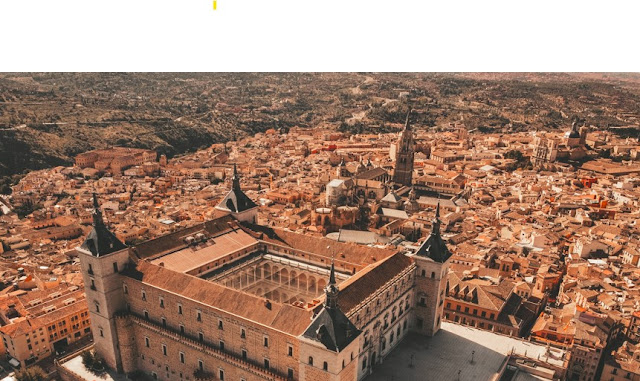Introduction:
Embark on a captivating journey through time as we delve into the remarkable Muslim history of Spain, known as Al-Andalus. Spanning from the 8th to the 15th century, this period witnessed the harmonious coexistence of Islamic, Christian, and Jewish cultures, resulting in a flourishing civilization that left an indelible mark on Spain's heritage. From the arrival of Islam to the cultural centers of Cordoba and Granada, we will explore the diverse aspects that shaped Muslim Spain's extraordinary cultural legacy.
The Advent of Islam in Spain:
In the 8th century, the forces of the
Umayyad dynasty, under the leadership of Tariq ibn Ziyad, made their way across
the Strait of Gibraltar, signifying the commencement of the Muslim conquest of
the Iberian Peninsula. This momentous occurrence ushered in a notable era of
religious tolerance and cultural exchange within the region, known as
Al-Andalus. The arrival of Islam cultivated a thriving society where Muslims,
Christians, and Jews coexisted harmoniously, leaving an enduring imprint. It is
crucial to emphasize that the Islamic rulers of Al-Andalus held a deep respect
for the existing communities, granting them the freedom to practice their
respective religions while safeguarding their unique cultural traditions.
During the Muslim reign, Al-Andalus
witnessed a remarkable period of prosperity and intellectual enlightenment. The
Arab conquerors introduced innovative agricultural techniques, particularly the
implementation of sophisticated irrigation systems, which revolutionized the
agricultural landscape of Spain. This transformative endeavor resulted in
heightened agricultural productivity, improved living standards, and the
emergence of prosperous urban centers. Al-Andalus swiftly evolved into a
vibrant hub for trade, commerce, and knowledge, attracting scholars, artisans,
and merchants from diverse corners of the globe. The exchange of ideas and the
flow of goods significantly contributed to the economic and cultural growth of
the region.
Cordoba: The Cultural and
Intellectual Center:
Cordoba, the capital of Al-Andalus, bloomed
into a center of culture, intellect, and architectural marvels. The crown jewel
was the Great Mosque of Cordoba, an architectural masterpiece decorated with
intricate arches and incredible mosaics. Cordoba became a hub for scholars, scientists,
and philosophers, boasting a grand library with a vast collection of books, making
it an inspiration for knowledge and enlightenment.
The mosque was expanded over the
centuries, converting into a complex city within a city, encompassing beautiful
gardens, fabulous courtyards, and serene prayer halls. The intellectual
atmosphere of Cordoba attracted scholars from various disciplines, nurturing an
environment of intellectual exchange and producing advancements in medicine,
mathematics, astronomy, and philosophy.
Alhambra: A Splendid Gem:
The Alhambra snuggled in the
enchanting city of Granada, stands as a testament to the magnificence and
artistic brilliance of Muslim Spain. This majestic fortress complex showcases delicate
Islamic architecture, including the Nasrid Palaces with their intricate stucco
work and serene courtyards. The Alhambra characterizes the harmonious
integration of nature and design, appealing to visitors with its ethereal beauty.
Walking through the Alhambra is like stepping into a world of poetic beauty and refined artistry. Each room, archway, and garden reflects scrupulous attention to detail, with intricately carved calligraphy, geometric patterns, and vibrant tiles. The Alhambra offers a glimpse into the luxurious lifestyle of the Nasrid dynasty and its appreciation for art, literature, and aesthetics.
Toledo: The City of Coexistence:
Toledo, known as the "City of
Three Cultures," represented religious and cultural harmony. Christians,
Muslims, and Jews coexisted, sharing knowledge and ideas that drove the
region's intellectual pursuits. Toledo became a center for translation,
preserving ancient knowledge through the translation of Greek, Roman, and
Arabic texts into Latin. The city's multicultural environment fostered artistic
creativity, resulting in gorgeous artwork and craftsmanship.
Toledo became renowned for its skilled artisans and craftsmen who produced complex metalwork, ceramics, and textiles. The city's architecture reflected a fusion of Islamic, Christian, and Jewish impacts, with mosques, churches, and synagogues coexisting side by side. The famous School of Translators in Toledo played a crucial role in preserving and spreading knowledge from different cultures, fostering a spirit of intellectual curiosity and alliance.
Contributions to Science, Art, and
Literature:
Muslim Spain made momentous
contributions to various fields, leaving a permanent impact on
science, art, and literature. Scholars like Averroes and Avicenna advanced
medicine, philosophy, and astronomy, paving the way for future discoveries.
Islamic art flourished, with calligraphy, geometric patterns, and exciting
ceramics adorning buildings and manuscripts. Literature flourished, producing
renowned poets and philosophers like Ibn Arabi and Ibn Hazm, whose works
explored love, spirituality, and ethics.
The translations of ancient Greek and Roman texts into Arabic supplemented the intellectual landscape of Al-Andalus, inspiring new ideas and shaping the development of scientific and philosophical thought. Muslim scholars played a dynamic role in preserving the works of ancient philosophers and scientists, which would later find their way back to Europe during the Renaissance, influencing the course of Western civilization.
In conclusion,
the enduring
legacy of Muslim Spain, Al-Andalus, displays a time of cultural
exchange, intellectual enlightenment, and architectural marvels. It serves as a reminder
of the power of coexistence, leaving us in amazement at the contributions and
richness that appeared during this remarkable period in Spain's history. The
heritage of Al-Andalus continues to inspire and mesmerize, inviting us to
explore and appreciate the multicultural tapestry that shaped the soul of
Spain.
Explore the
captivating Muslim history of Spain, Al-Andalus, through the following
keywords: Muslim history, Spain, Al-Andalus, Islamic rulers, religious
tolerance, cultural exchange, agriculture, irrigation systems, trade, commerce,
knowledge, Cordoba, Great Mosque, intellectual center, Alhambra, Nasrid
Palaces, art, architecture, Toledo, City of Coexistence, School of Translators,
science, literature, Averroes, Avicenna, Islamic art, translations,
intellectual landscape, Renaissance, Western civilization. Moorish era







0 Comments